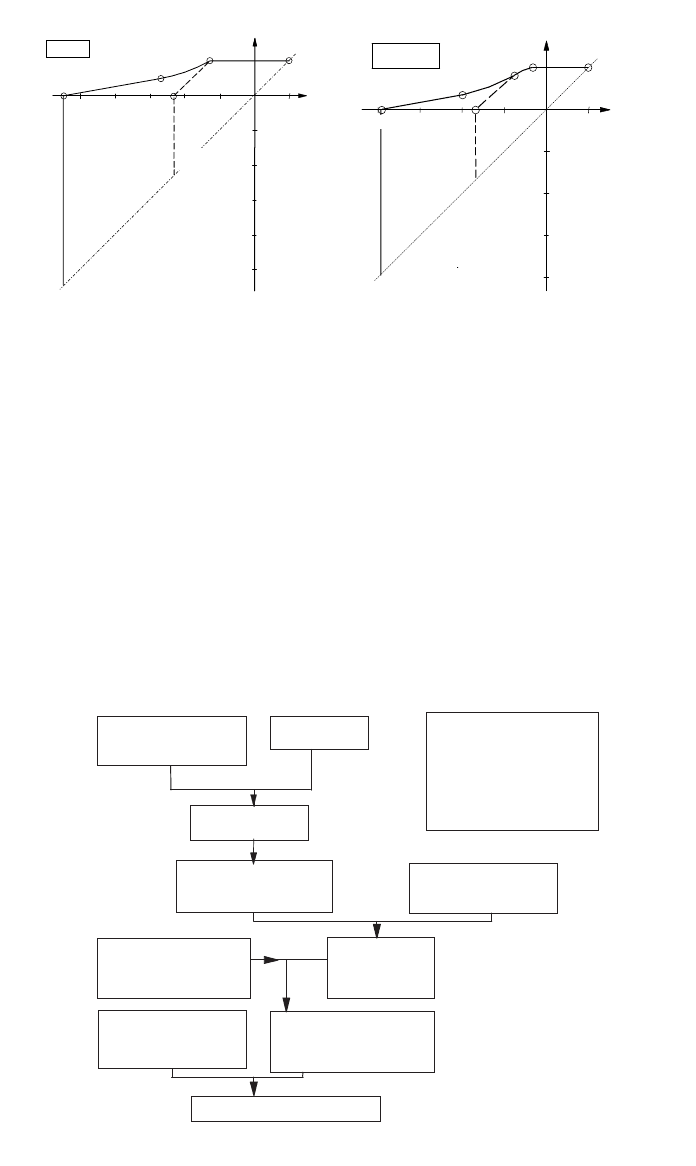Kutz M. Handbook of materials selection
Подождите немного. Документ загружается.


7 DESIGN APPLYING MULTIAXIAL WEIBULL STATISTICS 801
concluded that the ratio of compressive to tensile strength may vary between
about 3 and 6, depending on the shape of the pore and the Poisson ratio. It also
shows that Mohr’s hypothesis is a good approximation to the more detailed pore
models.
For a given pore geometry (spherical or ellipsoidal with a given ration of
b/a), the strength is independent of the size of the pore. Consequently, it is not
possible to derive a statistical multiaxial failure relation. Such a relation can be
obtained for a crack model. In this model the flaws are described as cracks with
a given shape, e.g., as circular cracks or semicircular surface cracks. Then, a
statistical multiaxial failure criterion can be developed in the following steps.
The cracks are assumed to be randomly orientated and have a size distribution
that leads to the Weibull distribution of the strength under uniaxial loading.
Depending on the orientation of the flaw with respect to the principal stress axis
and the ratios of the principal stresses
␣
and

, the stresses at the crack tip are
described by the mixed mode stress intensity factors K
I
, K
II
, and K
III
: K
I
is caused
by the normal stress on the crack area
n
; K
II
and K
III
are caused by the shear
stress
acting on the crack plane. The local failure criterion is a relation between
these three stress intensity factors and the fracture toughness K
IC
. Different re-
lations are discussed in literature, some of them also include the fracture tough-
ness K
IIC
for mode II loading. An example is the criterion of constant energy
release rate:
1
22 2 2
K ⫹ K ⫹ K ⫽ K (25)
I II III IC
1 ⫺
For any local stress state a critical orientation of the crack exists. If the normal
stress is compressive (
n
⬍ 0), then K ⫽ 0 and K
II
and K
III
have to be calculated
with an effective shear stress:
兩
兩 ⫹
for 兩
兩 ⬍
nn
⫽ (26)
再
eff
0 for 兩
兩 ⬎
n
with the friction coefficient
. As an example, the resulting failure criterion is
shown for circular cracks and a specific mixed mode failure criterion in Fig. 10.
If the scatter of the strength is included in the calculation procedure, the
resulting failure criterion also depends on the Weibull parameter m. For details
see Ref. 2.
For an inhomogeneous stress distribution the failure probability of a com-
ponent is given by the integral of
m
1
*
c
mm
F ⫽ 1 ⫺ exp ⫺ 冕冕h sin ⌽ d⌽ d⌿ 冕gdV (27)
冋冉冊
2
I0
The angles ⌽ and ⌿ characterize the orientation of the crack normal to the
principal stress axis. The quantity h depends on the stress ratios
␣
and

and
on the mixed-mode fracture criterion;
I0
is a material-dependent critical stress.

802 FAILURE MODES
–1
–2
–3
–5
–4
1
1
σ
1
/
σ
ct
–1
–2–3–4
–5
µ
=1
A
B
C
D
D
k=0.8
σ
2
/
σ
c
t
µ
=0
-1
-2
-3
-4
1
1
-1
-2-3
A
B
C
D
k=1.5
E
E
-4
σ
1
/
σ
ct
σ
2
/
σ
ct
µ
=1
µ
=0
Fig. 10 Failure diagram for circular cracks (k characterizes
the mixed mode criterion). (From Ref. 2.)
Load
(mechanical, thermal)
Geometry
α
=
σ
2
/
σ
1
β
=
σ
3
/
σ
1
ψ
,
Φ
crack normal
x,y,z
coordinates in
the component
crack model
e.g. circular crack
K
I
(
σ
n
)
K
II
(
σ
n
,
τ
)
K
III
(
σ
n
,
τ
)
local fracture criterion
=
σ
1
h(α,β,Φ,Ψ)
Failure probability
σ
n
(σ
1
,α,β,ψ,Φ,x,y,z)
τ
(σ
1
,
α
,
β
,
ψ
,
Φ
,x,y,z)
σ
ij
(x,y,z)
Weibull parameters
m
,
σ
I0
f(K
I
, K
II
, K
III
)=const.
σ
Ieq
(
σ
1
,
α
,
β
,
Φ
,
Ψ
)
Fig. 11 Flowchart for computation of failure probability for
multiaxially loaded components. (From Ref. 2.)
The flowchart for the computation of the failure probability is presented in
Fig. 11. It shows the necessary input information:
●
The stress state in the component (usually from finite-element calculation)
●
A crack model
●
A local failure criterion
●
The material properties m and
I0
Postprocessor programs are available for the calculation of failure properties.

8 MATERIALS SELECTION FOR THERMAL SHOCK CONDITIONS 803
Summary
●
The failure probability of components under multiaxial loading can be
calculated applying multiaxial Weibull theory, where the flaws are de-
scribed as randomly orientated cracks.
●
As a global multiaxial fracture criterion Mohr’s hypothesis can be applied.
8 MATERIALS SELECTION FOR THERMAL SHOCK CONDITIONS
Ceramic materials may fail during rapid cooling or rapid heating. Due to the
time-dependent transient temperature distribution in a component, the thermal
expansion depends on the location and has to be compensated by mechanical
deformation. Whereas in metals these strains lead to small local plastic defor-
mation, they may cause high local stresses in ceramics that may exceed the local
strength. The failure probability of a component under thermal shock conditions
can be calculated applying the multiaxial Weibull statistics described in Sec-
tion 7.
The resistance against thermal shock varies for different materials. It depends
on the following material properties: Thermal expansion coefficient
␣
, elastic
properties Young’s modulus E, Poisson’s ratio
, thermal conductivity
, density
, head capacity C
p
, and strength
c
. Under different thermal conditions different
thermal shock parameters have been defined, which characterize the thermal
shock sensitivity.
For perfect heat transfer from the medium to the component the thermal stress
at the surface after a thermal shock by
⌬T is
E
␣
⌬T
⫽ (28)
max
1 ⫺
The critical temperature for fracture under thermal shock therefore is
(1 ⫺
)
c
R ⫽ (29)
E
␣
For cooling with a constant heat transfer coefficient h the maximum stress at
the surface increases with time and decreases after passing a maximum. The
maximum stress is given by
E
␣
⌬T
⫽ ƒ(B) (30)
max
1 ⫺
where ƒ is a function of the Biot modulus
hd
B ⫽ (31)
where
is the thermal conductivity, and d a characteristic size parameter of the

804 FAILURE MODES
component. For small values of B the maximum stress is proportional to B.
Hence the critical temperature for failure is proportional to
(1 ⫺
)
c
R⬘ ⫽ (32)
E
␣
For a constant heating rate at the surface the maximum stress is
␣
E
C
dT
p
⫽⫺C (33)
max
(1 ⫺
) dt
where
is the density, C
p
the heat capacity, and C a constant depending on the
geometry. The critical heating rate therefore is proportional to
(1 ⫺
)
c
Rⴖ ⫽ (34)
E
␣
C
p
Whereas under mechanical loading a crack extends unstably after initiation,
a crack stops after some extension under thermal shock conditions. The remain-
ing strength, however, decreases considerably. If the strength of the component
is not of importance, a limited amount of crack extension may be tolerable.
Then, the condition for materials selection may be a small extension of an ex-
isting crack. It can be shown that the amount of crack extension during thermal
shock increases with increasing crack size. Consequently a material with a large
initial crack may be of advantage. The initial crack size follows from
2
K
IC
␣
⫽ (35)
冉冊
i
Y
c
leading to another thermal shock parameter
2
K
IC
Rⴖⴖ ⫽ (36)
2
c
(a Rⴖⴖ is not considered here).
In Table 5 typical values of the thermal shock parameters are given.
Summary
●
The sensitivity to failure by thermal shock increases with increasing
Young’s modulus, increasing thermal expansion coefficient, decreasing
strength, and decreasing thermal conductivity.
●
For a constant heating rate at the surface the sensitivity decreases further
with increasing density and increasing heat capacity.

9 FAILURE AT HIGH TEMPERATURES 805
Table 5 Thermal Shock Parameters for Different Materials
Al
2
O
3
MgO ZrO
2
SiC
Si
3
N
4
HPSN RBSN BeO Al
2
TiO
5
␣
(10 K
⫺
1
)
⫺
6
8 12 11 4 3.2 2.5 8 1.8
E (GPa) 400 270 200 350 300 180 360 30
0.22 0.17 0.25 0.2 0.28 0.23 0.25 0.2
(W m
⫺
1
K
⫺
1
) 30 30 2.5 100 35 10 300 2.5
(g cm
⫺
3
) 3.9 3.5 6.0 1.0 0.7 0.7 1.3 0.7
C (J g
⫺
1
K
⫺
1
) 1.0 1.0 0.5 1.0 0.7 0.7 1.3 0.7
c
(MPa) 300 180 950 360 660 200 180 65
K
IC
(MPa m
1/2
) 4.5 3.0 10 4 7 2 4.8 —
R (K) 73 46 324 206 495 342 47 962
R
⬘ (kW m
⫺
1
) 2.19 1.38 0.81 20.6 17.3 3.42 14.1 2.41
R
ⴖ (W cm
2
g
⫺
1
K) 5.6 3.9 2.7 66 75 20 36 9.6
R
ⴖⴖ (mm) 0.23 0.28 0.11 0.12 0.11 0.10 0.71
9 FAILURE AT HIGH TEMPERATURES
Failure at high temperatures is caused by creep elongation and creep rupture.
Another failure mode is oxidation. Different mechanisms may contribute to creep
and creep damage. In many cases, creep is caused by grain boundary effects,
such as viscous flow of an amorphous grain boundary phase, diffusion of va-
cancies along grain boundaries, formation and extension of cavities at grain
boundaries or dissolution, and reprecipitation of material through the glassy
phase. Creep within the grain is caused by the motion of dislocations or vacan-
cies.
Damage mechanisms leading to the rupture of a component can be the for-
mation of grain boundary cavities, coalescence to cracks, and growth of the
cracks until final failure.
9.1 Creep Strain
After application of a load to a specimen, the same variation of strain with time
as in metals is observed. After an instantaneous strain
0
, the creep curve can
be subdivided into three stages. In stage I—the primary creep—the strain rate
decreases and reaches in stage II—secondary creep—a constant value. After-
wards, in stage III—tertiary creep—the strain rate increases.
Primary creep can be described by one of the following relations:
m
⫽ At with m ⬍ 1 (36a)
p
⫽ A[1 ⫺ exp(⫺mt)] (36b)
p
The effect of the stress on the creep rate very is often described by Norton’s
law:
n
˙ ⫽ B
(37)
Other proposed relations are

806 FAILURE MODES
60 80 100 150 200 300
–10
–9
–8
–7
–6
Slope=11
Slope=13
Slope=3.5
Slope=3.8
Tension
Compression
1300°C
σ
(MPa)
lg
ε
s
(
ε
in 1/s)
Fig. 12 Stress dependence of the secondary creep rate for reaction-bonded siliconized silicon
carbide tested under tension and compression (from Ref. 4).
˙ ⫽ B[exp(
␣
) ⫺ 1] (38)
˙
⫽ B sinh(
␣
) (39)
These relations can be applied for the primary and secondary creep range with
possibly different parameters
␣
and n.
Creep under compression differs from creep in tension especially for second-
ary creep, where the creep rate in compression is lower than under tension. An
example is shown in Fig. 12. In this case the exponent n in Eq. 37 is similar in
tension and compression, the constant B, however, is different. Figure 12 also
shows that Eq. 37 cannot be applied for the whole range of the stress: The
exponent n for small stresses is lower than at higher stresses.
The effect of temperature usually can be described by
Q
˙ ⫽ C exp ⫺ (40)
冉冊
RT
where R is the gas constant and Q the activation energy for the leading creep
process. An example of Eq. 40 is shown in Fig. 13.
The problem of these relations is that the lowest creep rates measured are
usually higher than the allowable creep rate in a component. It is obvious from
Fig. 12 that the lowest creep rates measured in these investigations are in the
order of 10 /s. For this creep rate the creep strain is 3% in one year. Therefore
⫺
9
an extrapolation to lower creep rates often is necessary.
9.2 Creep Rupture
The mechanism of creep rupture differs from the mechanism of subcritical crack
extension at low temperatures. This can be seen in Fig. 14, where the stress is
plotted versus the lifetime for an alumina at 1100
⬚C in a log-log plot. Two ranges
can be distinguished. At high stresses, the failure is caused by the extension of
preexisting flaws. The relation between stress and failure strain can be described

9 FAILURE AT HIGH TEMPERATURES 807
678
–7
–6
–5
–4
–3
–2
(
ε
in 1/h)
678
σ
=70.5 MPa
10
–4
1/ T (K
–1
)
l
ε
s
Fig. 13 Secondary creep rate as a function of temperature for three hot-pressed
silicon nitrides. (From Ref 5.)
40
60
80
100
120
0
(MPa)
1
0.01
100
(h)
t
f
Fig. 14 Lifetime as a function of the (elastically calculated) outer fiber bending stress
for static bending tests on Al
2
O
3
with 4% glass content. Solid line predictions
from subcritical crack growth.
by Eq. 3a with n ⫽ 12 [the slightly curved line in Fig. 14 is obtained by applying
Eq. 3a for the bending tests taking into account small stress redistribution due
to creep]. At lower stresses, the observed lifetime is much lower than predicted
from Eq. 3.
Summary
●
Creep at high temperatures is described by relations between creep rate,
stress, and temperature.
●
The time to failure in the creep range is less stress dependent than at
lower temperatures.

808 FAILURE MODES
REFERENCES
1. S. Usami, I. Takahashi, and T. Machida, ‘‘Static Fatigue Limit of Ceramic Materials Containing
Small Flaws,’’ Eng. Fract. Mech. 25, 483–495 (1986).
2. D. Munz and T. Fett, Ceramics—Mechanical Properties, Failure Behaviour, Materials Selection,
Springer, Berlin, 1999.
3. G. Sines and M. Adams, Compression Testing of Ceramics, Fracture Mechanics of Ceramics, Vol.
3, Plenum, New York, 1978, pp. 403–434.
4. D. F. Caroll and S. M. Wiederthom, ‘‘High Temperature Creep Testing of Ceramics,’’ in Mechan-
ical Testing of Engineering Ceramics at High Temperatures, Elsevier Applied Science, London,
1989, pp. 135–149.
5. R. Kossowsky, D. G. Miller, and E. S. Diaz, ‘‘Tensile Creep Strength of Hot-pressed Si
3
N
4
,’’ J.
Mater. Sci. 10, 983–997 (1975).

809
CHAPTER 28
MECHANICAL RELIABILITY
AND LIFE PREDICTION
FOR BRITTLE MATERIALS
G. S. White
E. R. Fuller, Jr.
S. W. Freiman
Ceramics Division
Materials Science and Engineering Laboratory
National Institute of Standards and Technology
Gaithersburg, Maryland
1 SCOPE 809
2 INTRODUCTION 809
3 OVERVIEW 810
4 SUMMARY 818
APPENDIX 1: WEIBULL TESTS 818
APPENDIX 2: STRENGTH AND
DYNAMIC FATIGUE TESTS 821
APPENDIX 3: CONFIDENCE
LIMITS 824
REFERENCES 825
1 SCOPE
This chapter is intended to provide the reader with a general understanding of
why brittle materials fail in a time-dependent manner in service and how to
estimate the lifetimes that can be expected for such materials. In addition, we
describe procedures to evaluate the confidence with which these lifetime predic-
tions can be applied. Throughout this chapter, we assume that the material under
investigation can be treated as isotropic and homogeneous, and that microstruc-
tural influences on properties can be ignored. Therefore, more complicated is-
sues, such as crystallographic texture, grain-boundary phases, and R-curve
behavior, lie outside the scope of this discussion and will not be addressed
herein.
2 INTRODUCTION
Techniques to determine reliability of components fabricated from brittle mate-
rials (e.g., ceramics and glasses) have been extensively developed over the last
30 years.
1–7
Reliability is generally defined as the probability that a component,
or system, will perform its intended function for a specified period of time.
8
Accordingly, the two overarching principles influencing reliability are the statis-
tical nature of component strength and its time-dependent, environmentally en-
HandbookofMaterialsSelection.EditedbyMyerKutz
Copyright Ó 2002 John Wiley & Sons, Inc., NewYork.

810 RELIABILITY AND LIFE FOR BRITTLE MATERIALS
hanced degradation under stress. The statistical aspect of strength derives from
the distribution of the most severe defects in the components (i.e., the strength-
determining flaws).
9–15
The time-dependent aspect of strength results from the
growth of defects under stress and environment, resulting in time-dependent
component failure.
16–19
These concepts have lead to a lifetime prediction for-
malism that incorporates strength and crack growth as a function of stress. Pre-
dicted reliability, or lifetime, is only meaningful, however, when coupled with a
confidence estimate. Therefore, the final step in the lifetime prediction process
must be a statistical analysis of the experimental results.
2,20–22
While phenomenological, the reliability methodology has been useful in pre-
dicting lifetimes for myriad applications, including all-glass aircraft windows,
22
spacecraft
23,24
windows, flat panel displays,
25
optical glass fibers,
26
porcelain in-
sulators,
27
vitreous grinding wheels,
28
and electronic substrates.
29
Moreover, al-
though developed for isotropic and homogeneous materials, the methodology
appears to be generally valid for most fine-grain ceramic materials,
7,30–32
and
perhaps for single-crystal materials.
The lifetime prediction approach, described below, represents the currently
accepted procedures of reliability assessment for homogeneous, brittle materials.
There are, of course, a number of assumptions built into any technical procedure
and, frequently, these assumptions cannot be tested. The assumptions inherent
in steps associated with lifetime prediction are clearly stated in this chapter, and
implications that arise if the assumptions are violated are discussed at the end
of each section.
The structure of this chapter has been chosen to allow the user to access
easily regions of particular interest. It has been arranged to provide a general
overview of the processes involved in lifetime prediction of brittle materials
followed by a series of appendixes that describe the technical details and re-
quirements for each of the different stipulated experimental procedures. The
overview describes why the various measurement procedures are necessary and
how they fit into an overall lifetime prediction model. For details associated with
the derivation of the models, the user is directed to the references at the end of
the chapter.
3 OVERVIEW
General Considerations
The most basic assumption made in this chapter is that the material whose
lifetime is of interest is truly brittle; that means there are no energy dissipation
mechanisms (e.g., plastic deformation, internal friction, phase transformations,
creep) other than catastrophic bond rupture occurring during mechanical failure.
It has been well documented that brittle materials fail from flaws that locally
amplify the magnitude of stresses to which the material is subjected.
9,10,14,15,33
These flaws, e.g., scratches, pores, pits, inclusions, or cracks, result from proc-
essing, handling, and use conditions. For a given applied or residual stress, the
initial flaw distribution determines whether the material will survive application
of the stress or will immediately fail. Similarly, the evolution of the flaw pop-
ulation with time determines how long the surviving material will remain intact.
Other key assumptions in reliability predictions for brittle materials are that
the experiments used to determine inert strength distributions do not alter the
